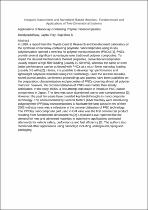JavaScript is disabled for your browser. Some features of this site may not work without it.
- ResearchSpace
- →
- Research Publications/Outputs
- →
- Book Chapters
- →
- View Item
| dc.contributor.author |
Bandyopadhyay, J

|
|
| dc.contributor.author |
Ray, Suprakas S

|
|
| dc.date.accessioned | 2018-08-24T08:06:07Z | |
| dc.date.available | 2018-08-24T08:06:07Z | |
| dc.date.issued | 2017-07 | |
| dc.identifier.citation | Bandyopadhyay, J and Ray, SS. 2017. Applications of nanoclay-containing polymer nanocomposites. Inorganic Nanosheets and Nanosheet-Based Materials, pp 501-521. | en_US |
| dc.identifier.isbn | 978-4-431-56496-6 | |
| dc.identifier.uri | http://www.springer.com/gp/book/9784431564942 | |
| dc.identifier.uri | https://doi.org/10.1007/978-4-431-56496-6_21 | |
| dc.identifier.uri | http://hdl.handle.net/10204/10389 | |
| dc.description | Copyright: 2017 Springer. Due to copyright restrictions, the attached PDF file only contains the abstract of the full text item. For access to the full text item, kindly consult the publisher's website. | en_US |
| dc.description.abstract | In 1989, a report from the Toyota Central Research and Development Laboratory on the synthesis of nanoclay-containing polymide nanocomposites using in situ polymerization opened a new era for polymer nanocomposites (PNCs). PNCs provide several significant advantages over traditional polymer composites. To impart the desired mechanical or thermal properties, conventional composites usually require a high filler loading (usually 10-50 wt%), whereas the same or even better performance can be achieved with PNCs at a much lower nanoclay loading (usually 3-5 wt%) [2]. Hence, it is possible to develop high-performance and lightweight polymeric materials using PNC technology. Over the last two decades, severl journal articles, conference proceedings and patents have been published on the preparation, characterization and properties of PNCs covering almost all polymer matrices: however, the commercialization of PNCs was harder than initially anticipated. In the early 1990s, a first attempt was made to introduce PNC-based components in Japan. The idea was soon abandoned due to cost-competiveness. However, the past few years have provided key breakthroughs in nanocomposite technology. The announcement by General Motors (GM) that they were introducing polypropylene (PP)/clay nanocomposites to fabricate the step assist in two of their 2002 mid-size vans was a milestone in the commercialization of PNC technology. The PP/clay nanocomposite part used in GM vans was the first commercial product resulting from fundamental developments. Lloyd and Lave reported that the demand for new and advanced materials in automotive applications continued afterwards for vehicle safety, performance and fuel efficiency. The authors also mentioned other applications using nanoclays including underground piping and packaging. | en_US |
| dc.language.iso | en | en_US |
| dc.publisher | Springer | en_US |
| dc.relation.ispartofseries | Worklist;20338 | |
| dc.subject | Nanoclay | en_US |
| dc.subject | Polymer nanocomposites | en_US |
| dc.title | Applications of nanoclay-containing polymer nanocomposites | en_US |
| dc.type | Book Chapter | en_US |
| dc.identifier.apacitation | Bandyopadhyay, J., & Ray, S. S. (2017). Applications of nanoclay-Containing polymer nanocomposites., <i>Worklist;20338</i> Springer. http://hdl.handle.net/10204/10389 | en_ZA |
| dc.identifier.chicagocitation | Bandyopadhyay, J, and Suprakas S Ray. "Applications of nanoclay-containing polymer nanocomposites" In <i>WORKLIST;20338</i>, n.p.: Springer. 2017. http://hdl.handle.net/10204/10389. | en_ZA |
| dc.identifier.vancouvercitation | Bandyopadhyay J, Ray SS. Applications of nanoclay-containing polymer nanocomposites.. Worklist;20338. [place unknown]: Springer; 2017. [cited yyyy month dd]. http://hdl.handle.net/10204/10389. | en_ZA |
| dc.identifier.ris | TY - Book Chapter AU - Bandyopadhyay, J AU - Ray, Suprakas S AB - In 1989, a report from the Toyota Central Research and Development Laboratory on the synthesis of nanoclay-containing polymide nanocomposites using in situ polymerization opened a new era for polymer nanocomposites (PNCs). PNCs provide several significant advantages over traditional polymer composites. To impart the desired mechanical or thermal properties, conventional composites usually require a high filler loading (usually 10-50 wt%), whereas the same or even better performance can be achieved with PNCs at a much lower nanoclay loading (usually 3-5 wt%) [2]. Hence, it is possible to develop high-performance and lightweight polymeric materials using PNC technology. Over the last two decades, severl journal articles, conference proceedings and patents have been published on the preparation, characterization and properties of PNCs covering almost all polymer matrices: however, the commercialization of PNCs was harder than initially anticipated. In the early 1990s, a first attempt was made to introduce PNC-based components in Japan. The idea was soon abandoned due to cost-competiveness. However, the past few years have provided key breakthroughs in nanocomposite technology. The announcement by General Motors (GM) that they were introducing polypropylene (PP)/clay nanocomposites to fabricate the step assist in two of their 2002 mid-size vans was a milestone in the commercialization of PNC technology. The PP/clay nanocomposite part used in GM vans was the first commercial product resulting from fundamental developments. Lloyd and Lave reported that the demand for new and advanced materials in automotive applications continued afterwards for vehicle safety, performance and fuel efficiency. The authors also mentioned other applications using nanoclays including underground piping and packaging. DA - 2017-07 DB - ResearchSpace DP - CSIR KW - Nanoclay KW - Polymer nanocomposites LK - https://researchspace.csir.co.za PY - 2017 SM - 978-4-431-56496-6 T1 - Applications of nanoclay-containing polymer nanocomposites TI - Applications of nanoclay-containing polymer nanocomposites UR - http://hdl.handle.net/10204/10389 ER - | en_ZA |






